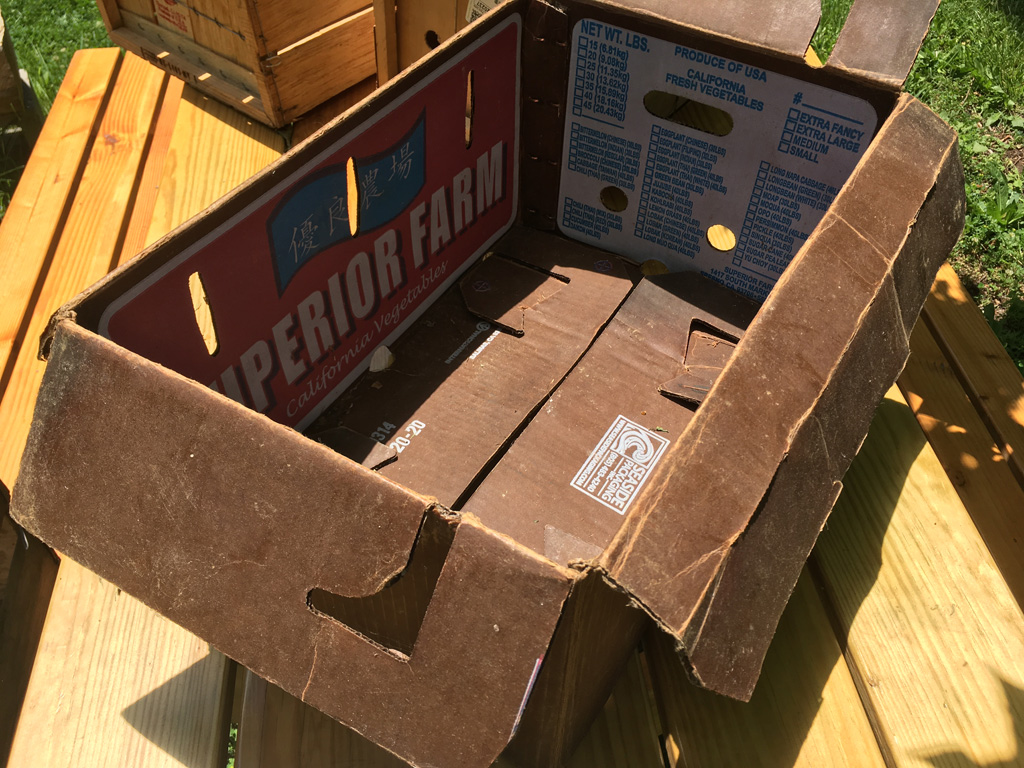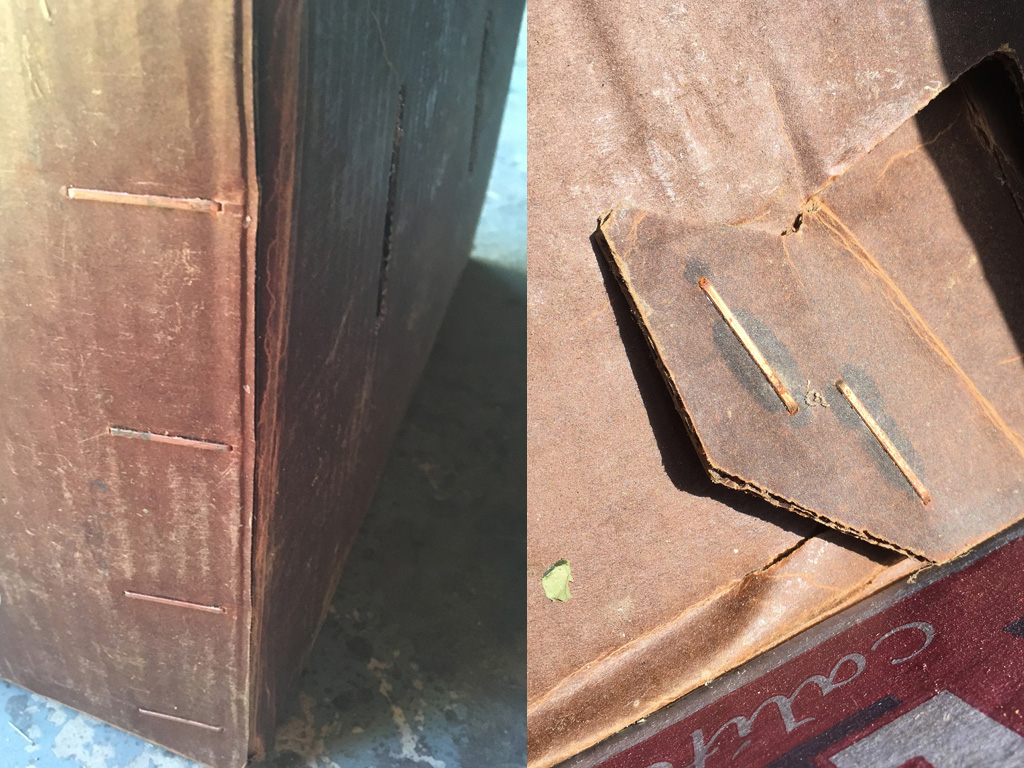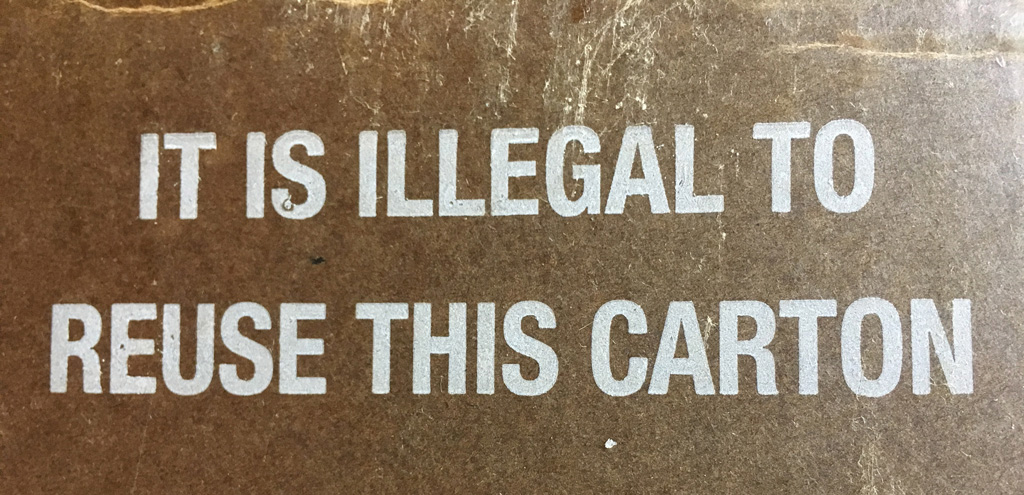As I mentioned in another article, most of the fruit, vegetables, and other fresh produce that arrives at your local supermarket is shipped in a wax-coated box that is generally not recycled. Although they could technically be reused, U.S. federal law effectively prohibits their reuse, largely because they cannot be sanitized between uses. Although plastic crates are increasingly entering the market and are described as “eco-friendly” because they can be sanitized, the produce distribution network does not actually accommodate their reuse. As a result, landfills are being filled with astounding amounts of wax and plastic crates. What are the reasons behind this pattern of activity, and can it be changed?
In my research trips to the friendly local produce market, I encountered many wax produce cartons, each printed with the name of a different faraway farm, often sporting fanciful and bucolic names and simple but intriguing graphics. But each was also emblazoned with the warning notice above, sternly reminding that the carton is not to be reused.

At first I assumed this was because produce farms wanted to jealously prevent competing farms from reusing the boxes they had paid to have printed with their own name. Perhaps the State of California or another farmer-supportive legislature had even supported this desire with a law. Such a shame, I thought, that petty market competition was the only thing sending these perfectly sound, reusable boxes en masse to the landfill.
But I was wrong about that. In an effort to find out exactly which law makes it “illegal to reuse this carton,” the only reference I could find was to the U.S. FDA’s guidelines on produce handling practices, known as the Food Safety Modernization Act (FSMA) Produce Safety Rule (PSR). This effectively prohibits the reuse of produce containers for most fresh produce, due in part to the requirement that they be sanitized between uses. The regulation is vague on what constitutes adequate sanitization, leaving no clear guidance as to what qualifies and what does not. But it’s fairly clear that wax boxes cannot be sanitized, at least not by heat, as that would melt the wax. Neither does the wax content allow them to be recycled with the regular cardboard. The result is that these boxes are routinely neither recycled nor reused, but are discarded into the landfill waste stream.
The fact that they are physically capable of being successfully reused was shown to me by a couple of renegade boxes that I was surprised and intrigued to encounter in my research. Below we have two boxes that were repurposed, by some distributor somewhere, by unfolding the box and refolding it, inside-out. This feat of applied origami is extraordinarily clever, though of unclear legality. The identity of the original owner of the box is now hidden on the inside, escaping the scrutiny of the farm that might not want its boxes reused by a competitor. On the outside is just generic brown cardboard — a plain brown wrapper, for vegetables traveling incognito.

To be clear, it is extremely unlikely that the produce farms whose names are printed on the inside of these boxes have anything to do with this activity. Most likely their used boxes are simply being converted by a third party who is reusing the boxes they receive in the course of their own business. But the fact that this is happening indicates that there is significant value embodied in the ongoing waste stream of used boxes — each of which cost more than $2.00 apiece, in bulk — enough to motivate someone to engage in this practice.

In order to unfold the box and still have it operate properly after being refolded backwards, the original glue bond has to be broken at the seam, and then re-stapled by an industrial stapler of the kind that is ordinarily only found in box factories or large industrial loading docks. It also has to be stapled at one of the bottom flaps, since the geometry of the closing tabs does not quite work as designed when re-folded in reverse. This indicates that this practice is not just the result of some farmer who ran out of boxes one day and had a burst of Yankee ingenuity, but is being done with forethought, premeditation, and specialized equipment. Somewhere, someone is saving these boxes from the landfill.

Interestingly, one of these reused boxes does not carry the warning that “it is illegal to reuse this carton.” Maybe, somehow, that makes it ok? Doubtful, but worth noting. The other does carry the warning — but with a qualification: “… without the written permission of Superior Farms.” Well, that certainly clouds things a bit! I would not think that an individual farm’s permission could override the safety provisions of the FDA regulation, if that is the driving force behind the warning. Maybe this message is evidence that my initial suspicion — that the real reason for these warning messages is based in cutthroat competition — may have some validity.

Personally, I applaud whoever is performing this carton origami, and I have no idea whether it is an underground activity or not. A light reading of the FDA regulation suggests that it supports the use of liners in boxes to make them reusable. Turning the box inside-out would seem to provide at least as much protection of the new contents from the old contents as a liner might. And it also removes the worry that the old markings on the box might confuse the origin of a recalled product — now there are no markings on the box at all. And finally, it proves that these boxes are in fact physically reusable, and can easily make it through the distribution cycle more than once — if the issues of traceability and statutory legality can be resolved.
No one disagrees that food safety and traceability in the event of a recall is important. But is there room within the Produce Safety Rule to be more supportive of sustainable solutions by being more clear on the requirements for reusability of produce containers? Otherwise, a kilogram of waxy landfill fodder will continue to be the cost of every bushel of produce our society produces.



One Comment
Pingback: